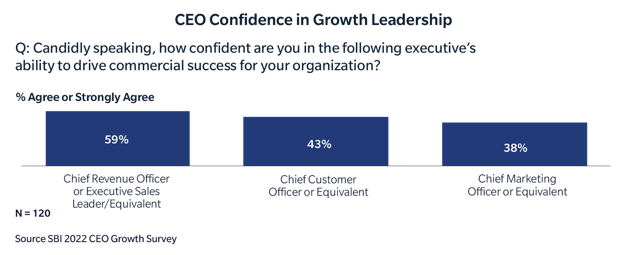CEOs view marketing as an expendable black box, especially during challenging times. Lack of clear visibility into how marketing drives revenue casts doubt on the CMO’s ability to support the CEO’s commercial productivity agenda. CEOs’ and CFOs’ limited GTM knowledge further complicates CMOs’ ability to defend budgets not clearly aligned to focused revenue growth.
Over 50% of CEOs don’t have faith in their CMOs’ ability to drive commercial performance today. Data from SBI’s July 2022 CEO Survey should give marketing leaders a reason to pause, then critically evaluate their current marketing charter and plan of action for the next 6-12 months.

Confidence is alarmingly low and CEOs with a clear and disciplined value-creation strategy will not allow anyone to stand in their way. Savvy CEOs get this and need capable CMOs to help them execute. Now is the time for CMOs to take decisive, bold action.
What does that look like? Take the actions below.
- Act without hesitation: Don’t keep your bets spread widely across channels and segments - cautiously waiting to see how the coming months play out. Follow the same approach CEOs are taking to create their annual revenue plans and narrow in on a focused set of initiatives to drive growth and value creation.
- Align with commercial productivity: Get laser-focused on your ICP and direct investment against accounts and customer segments that meet a refined set of criteria. SBI sees proactive CMOs taking focused action, transparently working with peers to maintain revenue growth, and ensuring visibility into marketing activity that is aligned with commercial productivity.
- Drive consistent data management: By driving consistent data routines, you enable rapid investigation into changing buyer behavior. Sharing this visibility on a consistent basis with your leadership counterparts shows you are ahead of the curve in predicting early indicators of shifting demand allowing for efficient GTM playbook changes before it’s too late.
- Don’t ignore signs of slipping demand: Now that you have the data, stop ignoring signs of slipping demand. CMOs should also be realistic about current market conditions and reprioritize more focused actions within their agenda - which may include those of the digital variety - to maintain revenue growth over the next few quarters of 2022 and 2023.
- Stop taking a backseat to the Chief Revenue Officer: You and the CRO are counterparts. Instead of taking a backseat to the CRO, confident CMOs boldly initiate challenging commercial conversations, leading the discussion on critical decisions and GTM strategy pivots needed to maintain revenue growth.
CMOs at the forefront of driving growth today are taking concrete actions, focusing on what they have and can control. They come armed with insight and initiate challenging commercial conversations with the CEO and their sales counterparts. They are not waiting for more data or process improvements. Rather, these adept CMOs are efficiently prioritizing investments, iterating rapidly to learn what works now, and driving internal consensus on GTM playbook updates. These actions result in success with little waste.
Be a trusted advisor to your CEO and clearly articulate your Marketing plan to drive commercial productivity. Click here to read the full report.

